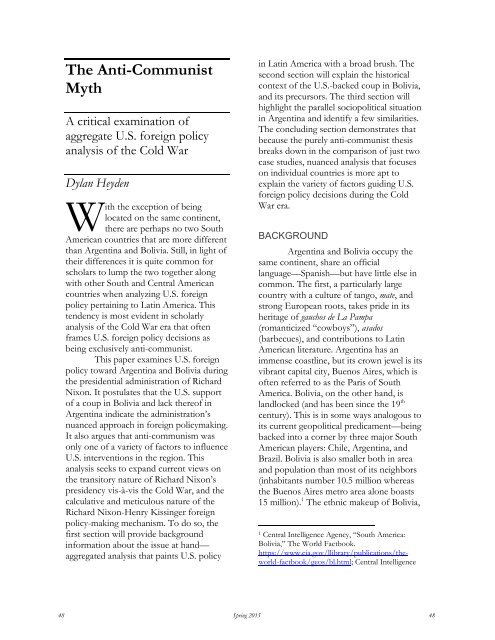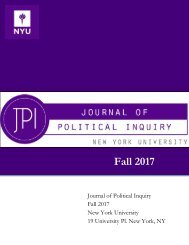JPI Spring 2015
Create successful ePaper yourself
Turn your PDF publications into a flip-book with our unique Google optimized e-Paper software.
The Anti-Communist<br />
Myth<br />
A critical examination of<br />
aggregate U.S. foreign policy<br />
analysis of the Cold War<br />
Dylan Heyden<br />
With the exception of being<br />
located on the same continent,<br />
there are perhaps no two South<br />
American countries that are more different<br />
than Argentina and Bolivia. Still, in light of<br />
their differences it is quite common for<br />
scholars to lump the two together along<br />
with other South and Central American<br />
countries when analyzing U.S. foreign<br />
policy pertaining to Latin America. This<br />
tendency is most evident in scholarly<br />
analysis of the Cold War era that often<br />
frames U.S. foreign policy decisions as<br />
being exclusively anti-communist.<br />
This paper examines U.S. foreign<br />
policy toward Argentina and Bolivia during<br />
the presidential administration of Richard<br />
Nixon. It postulates that the U.S. support<br />
of a coup in Bolivia and lack thereof in<br />
Argentina indicate the administration’s<br />
nuanced approach in foreign policymaking.<br />
It also argues that anti-communism was<br />
only one of a variety of factors to influence<br />
U.S. interventions in the region. This<br />
analysis seeks to expand current views on<br />
the transitory nature of Richard Nixon’s<br />
presidency vis-à-vis the Cold War, and the<br />
calculative and meticulous nature of the<br />
Richard Nixon-Henry Kissinger foreign<br />
policy-making mechanism. To do so, the<br />
first section will provide background<br />
information about the issue at hand—<br />
aggregated analysis that paints U.S. policy<br />
in Latin America with a broad brush. The<br />
second section will explain the historical<br />
context of the U.S.-backed coup in Bolivia,<br />
and its precursors. The third section will<br />
highlight the parallel sociopolitical situation<br />
in Argentina and identify a few similarities.<br />
The concluding section demonstrates that<br />
because the purely anti-communist thesis<br />
breaks down in the comparison of just two<br />
case studies, nuanced analysis that focuses<br />
on individual countries is more apt to<br />
explain the variety of factors guiding U.S.<br />
foreign policy decisions during the Cold<br />
War era.<br />
BACKGROUND<br />
Argentina and Bolivia occupy the<br />
same continent, share an official<br />
language—Spanish—but have little else in<br />
common. The first, a particularly large<br />
country with a culture of tango, mate, and<br />
strong European roots, takes pride in its<br />
heritage of gauchos de La Pampa<br />
(romanticized “cowboys”), asados<br />
(barbecues), and contributions to Latin<br />
American literature. Argentina has an<br />
immense coastline, but its crown jewel is its<br />
vibrant capital city, Buenos Aires, which is<br />
often referred to as the Paris of South<br />
America. Bolivia, on the other hand, is<br />
landlocked (and has been since the 19 th<br />
century). This is in some ways analogous to<br />
its current geopolitical predicament—being<br />
backed into a corner by three major South<br />
American players: Chile, Argentina, and<br />
Brazil. Bolivia is also smaller both in area<br />
and population than most of its neighbors<br />
(inhabitants number 10.5 million whereas<br />
the Buenos Aires metro area alone boasts<br />
15 million). 1 The ethnic makeup of Bolivia,<br />
1 Central Intelligence Agency, “South America:<br />
Bolivia,” The World Factbook.<br />
https://www.cia.gov/llibrary/publications/theworld-factbook/geos/bl.html;<br />
Central Intelligence<br />
48 <strong>Spring</strong> <strong>2015</strong> 48
















